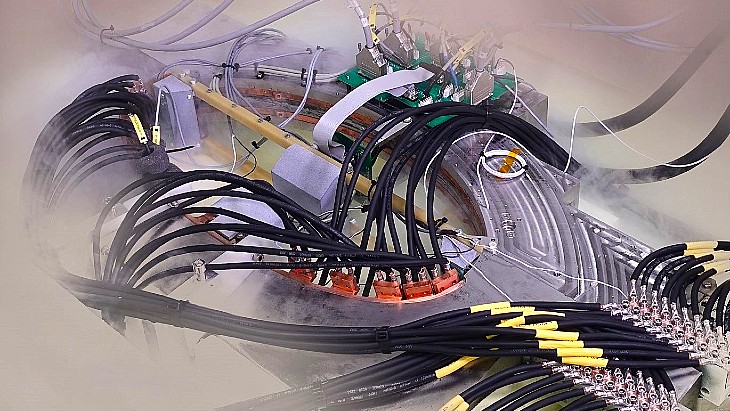Tokamak Energy reports Demo4 milestone cryogenic tests
Tokamak Energy says its engineers have successfully validated electromagnetic current test results of the first of 14 toroidal field limbs in liquid nitrogen at temperatures of -200 degrees Celsius.

The test took place in liquid nitrogen (Image: Tokamak Energy)
In February, Tokamak Energy announced it had built a world-first set of new generation high temperature superconducting (HTS) magnets to be assembled and tested in fusion power plant-relevant scenarios. Its Demo4 facility will consist of 44 individual magnetic coils manufactured using 38 kilometres of HTS tape, which carries currents with zero electrical resistance and requires five times less cooling power than traditional superconducting materials. A toroidal field (TF) limb "consists of two coils being joined, resin moulded and embedded into a structural steel 'clam shell'". The tests reported this week included checking the resistance of the joints required to pass the operational current between coils.
Demo4, which is due to be fully assembled and tested at Tokamak's headquarters in Milton Park, near Oxford in the UK, next year, will operate at -253 degrees Celsius.
Rod Bateman, Tokamak Energy's magnet development manager, said: "These first set of extremely positive results are a major step forward for the Demo4 project, which will allow us to create substantial magnetic forces and test them in fusion power plant-relevant scenarios for the first time. A magnet system of this kind has never been built before so for the first toroidal field limb to perform as we expected under rigorous cryogenic electromagnetic current testing is a huge achievement."
Tokamak Energy's plan to produce fusion energy requires strong magnetic fields to confine and control the plasma which is several times hotter than the centre of the Sun. Demo4 is being built to replicate the forces seen in a fusion energy power plant. It will be a "complete balanced set of magnets shaped in a tokamak configuration" with "12 million amps of electricity running through its central column when fully assembled", the company says.
Tokamak Energy's roadmap is to have commercial fusion power plants deployed in the 2030s. It says it has completed design work on its next advanced prototype fusion device which is scheduled for build completion later in the 2020s, and which will inform the design of a fusion pilot plant which "will demonstrate the capability of delivering electricity into the grid in the 2030s, paving the way for globally deployable 500-megawatt commercial plants".
Researched and written by World Nuclear News
- China Institute of Atomic Energy
- Nuclear Power Institute of China
- Southwestern Institute of Physics
- China Nuclear Power Operation Technology Corporation, Ltd.
- China Nuclear Power Engineering Co., Ltd.
- China Institute for Radiation Protection
- Beijing Research Institute of Uranium Geology (BRIUG)
- China Institute of Nuclear Industry Strategy (CINIS)
- China Nuclear Mining Science and Technology Corporation


